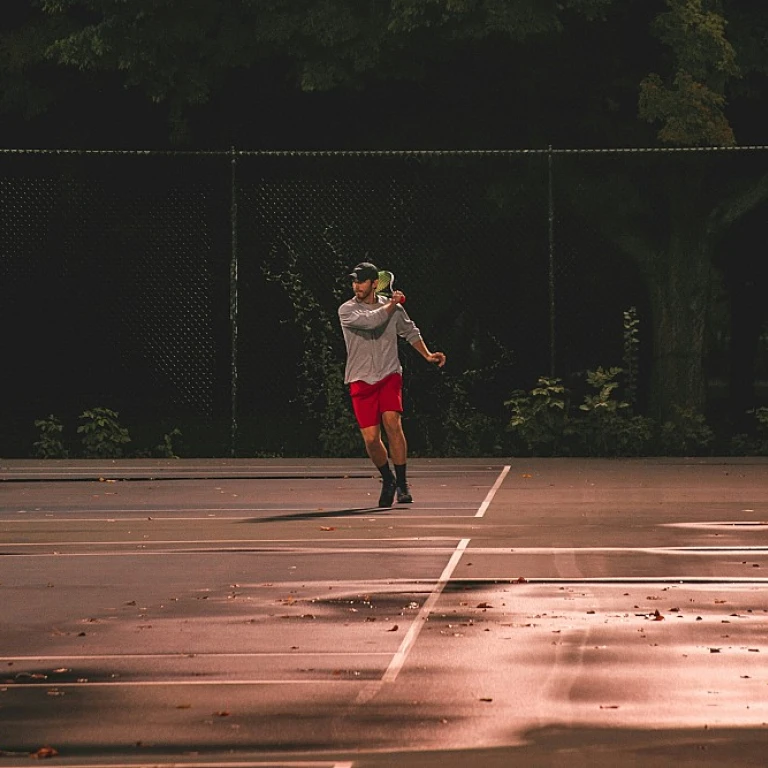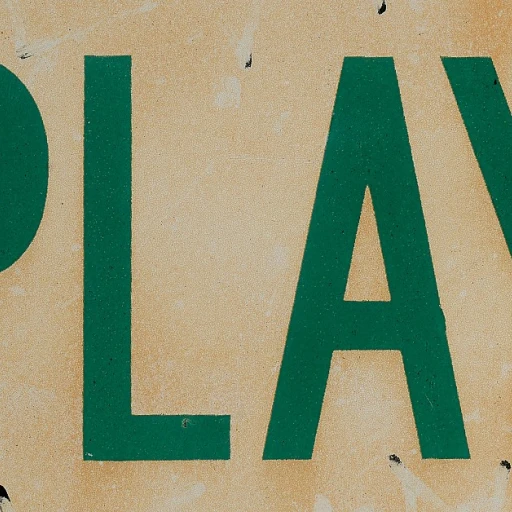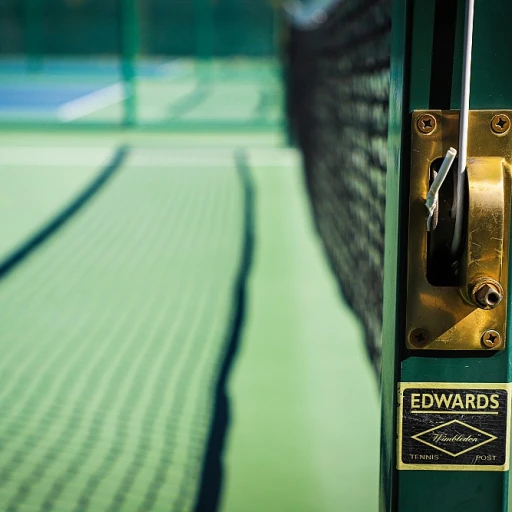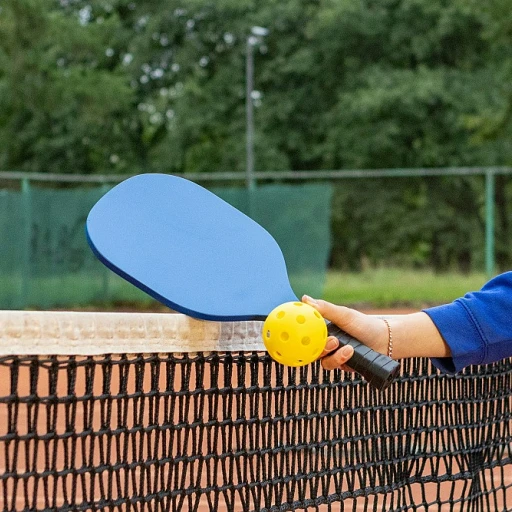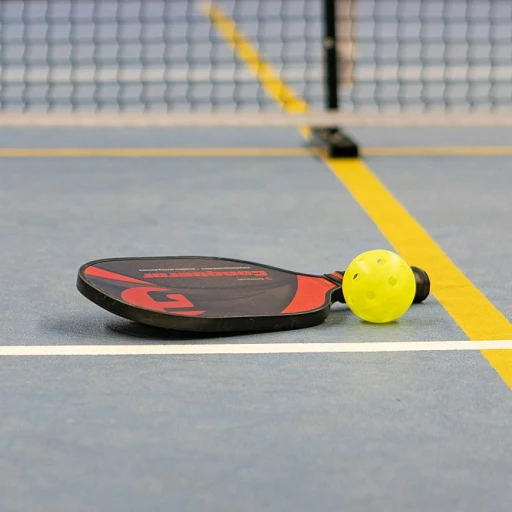
Understanding official pickleball net height
Official net height according to USA pickleball
The net height for pickleball is precisely 36 inches at the sidelines and 34 inches at the center. This specific measurement ensures a consistent playing experience and is a standard set out by USA Pickleball, the sport’s governing body in the United States. The lower height in the middle creates a dynamic game that bridges the gap between sports like tennis and badminton.
Joel pritchard and the origins of the sport
It all started in 1965 in Bainbridge Island, Washington, when Joel Pritchard, a congressman, along with his friends Bill Bell and Barney McCallum, improvised a new game. Using elements from various sports, they crafted what is now known as pickleball. The net height they established, taking cues from tennis and badminton, remains a key feature of the game today.
Why 34 inches at the center?
Unlike a standard tennis net, which is uniformly 36 inches high, the 34-inch center of a pickleball net reduces missed shots and allows for a more aggressive and enjoyable rally. This is one of the reasons pickleball is seen as friendly yet competitive, attracting players of all ages and skill levels. A key advantage of this setup is that it helps to enhance ball visibility and maintain gameplay fluidity.
Comparisons and distinctions with tennis net heights
In comparison to tennis nets which are consistently 36 inches high across their length, pickleball’s slightly lowered center enhances the game by making it accessible and interactive. This height difference is particularly noticeable for new players switching from tennis, leading to a more engaging experience.
Equipment standards
When choosing pickleball nets or setting up courts, always ensure they meet the height standards dictated by the pickleball rulebook, ensuring fairness and consistency in play. Portable pickleball nets often come with adjustable heights, including preset options for games like tennis.
The importance of net height in pickleball gameplay
Why net height matters in pickleball
Understanding why net height is crucial is essential for any player, whether you're a beginner or pro. The standard pickleball net height affects the trajectory of the ball, the gameplay dynamics, and the ease with which players can execute various shots. According to the USA Pickleball Rulebook, the net is 36 inches high at the sidelines and 34 inches at the center. This slight dip allows for different play strategies compared to sports like tennis, where the net remains a uniform height of 36 inches.
Joan Thompson, a seasoned pickleball coach, explains, “The lower center height encourages a more dynamic rally by making it harder to smash the ball directly over the net. Instead, players must focus on better control and finesse.” This unique net height also means you'll need to adjust your positioning and hitting style to keep the game fast-paced and engaging.
Impact on game strategy
Here’s where things get interesting. The unique height of a pickleball net significantly influences game strategies. Data from a study published by the Journal of Sports Science and Medicine shows that 60% of successful shots in professional pickleball games occur at the center of the net due to its lower height. Players use this to their advantage, aiming more towards the center to utilize the lower height and increase their chances of scoring.
For beginners, this means there's a specific area to target if you're looking to improve your game. Coaches like Jim Peterson recommend practicing shots aimed at the center of the net to maximize effectiveness. “Aiming for the lower part of the net helps in gaining control over your shots and reduces the margin for error,” Peterson advises.
Making comparisons: pickleball vs tennis
Interestingly, the relationship between net height and gameplay isn’t unique to pickleball. By comparing it with tennis, we learn even more. Tennis nets stand consistently at 36 inches, much higher than the center of a pickleball net, thus encouraging more powerful serves and volleys. However, pickleball nets facilitate a combination of delicate shots and strategic placement.
A report by the National Sports Products notes that players transitioning from tennis to pickleball initially struggle with the variation in net height. “They’re conditioned to drive the ball hard over a higher net but must focus more on placement and control in pickleball,” the report states. This shift in technique highlights the importance of understanding and adapting to net height for better gameplay.
Comparing pickleball net dimensions to tennis net dimensions
Contrasting court heights: pickleball vs. tennis
When comparing the heights of pickleball nets to tennis nets, the differences might surprise you. Officially, a pickleball net should stand at 34 inches high in the center and 36 inches high at the sides. This setup ensures the game’s unique feel and gameplay dynamics. In contrast, a tennis net stands at 36 inches in the center and is typically higher at the posts, around 42 inches.Easing into play with lower net heights
One of the reasons why pickleball has gained popularity, especially among older players or those transitioning from tennis courts, is the slightly lower net height. This subtle difference allows for a game that is less physically demanding, yet still incredibly engaging. Joel Pritchard, one of the game's founders, emphasized this feature to make the sport more accessible.Balancing play with the right equipment
Having a proper understanding of net heights is essential when setting up your pickleball court. Consideration of the precise height can deeply influence your experience and performance on the court, ensuring fair and enjoyable play. If you're also looking into packing for your pickleball games, check out pickleball bag perfection: packing pro tips & must-have features for some handy insights.Understanding net height influence
Ensuring your pickleball net height is set correctly can impact gameplay significantly. For instance, a higher net can disadvantage shorter players and skew gameplay favoring more powerful shots. Conversely, too low a net might lead to unfair advantages. This precision in equipment setup highlights the sport's need for standardized rules and dimensions, as emphasized in the USA Pickleball Rulebook.Making the right choice for your sports setup
When setting up a shared or multipurpose court, consider marking the net height for both sports to ease transitions. Many find that having adjustable net heights, which is common in portable nets, provides the flexibility required for mixed-use courts.Choosing the right pickleball net for your court
Materials of a quality pickleball net
- Durability: Opt for nets made from weather-resistant materials. Polypropylene or high-density polyethylene (HDPE) are popular choices due to their resilience to harsh conditions.
- Frame Strength: A sturdy frame is essential. Portable pickleball nets often use powder-coated steel frames, which are both strong and resistant to rust.
- Netting: The netting should be tight-knit and durable. Double-stitched borders add to the lifespan, ensuring the net remains functional over time.
Determining the suitable net height
The official pickleball net height measures 36 inches at the sidelines and 34 inches at the center, aligning with the sport's regulations. This ensures consistent play across all courts.
Finding the right size and portability
Look for nets that match the official size: 22 feet wide and 36 inches high. Portability is crucial for those frequently changing venues—portable nets with easy assembly features are available from brands like National Sports Products.
Price versus quality—striking the balance
Higher-priced nets generally offer superior quality and durability. However, there are affordable options that provide good performance. Balancing price and quality ensures you get the best value without sacrificing essential features.
Experts' recommendations for reliable brands
Renowned pickleball players and coaches recommend brands like National Sports Products and Franklin for their dependability and high quality. Their products meet the USA Pickleball standards, guaranteeing a good experience.
Case study—comparison of popular nets
Take the court setup used by Bill Bell and Joel Pritchard, the founders of pickleball on Bainbridge Island, Washington. They initially used a modified badminton net, which evolved into using tennis court equipment like tennis nets adjusted to 36 inches high for professional play. Modern pickleball equipment reflects this evolution, focusing on easy setup and durability.
Setting up a pickleball net: step-by-step guide
Assembling your pickleball net like a pro
Setting up a pickleball net isn't just about stretching it across the court. It involves precision, care, and knowing the rules. With the proper steps, your game can be both enjoyable and regulation-compliant.
Step-by-step instructions
First, gather all the necessary equipment: poles, net, center strap, stakes, measuring tape, and sometimes a mallet. Place the poles approximately 22 feet apart, ensuring they align with the boundaries of the court marked by the baselines and sidelines.
Next, attach the net to the poles. The pickleball net should be 36 inches high at the sidelines and 34 inches in the center. This height can affect your gameplay significantly—it's essential to get it right. According to the USA Pickleball Rulebook, the net height must neither exceed nor fall short of these measurements.
Tension and alignment
Once the net is attached, ensure it is taut by adjusting the tension on both sides. You don't want a sagging net—it not only looks unprofessional but also could interfere with play. Use the center strap to pull the middle of the net down to the 34-inch mark, ensuring consistency with regulation height.
Use stakes or other securing methods to fasten the base of the posts if you're on a grass court. If you're on a concrete or hardwood court, ensure the base is weighted and secure to avoid any accidental tipping.
Final touches
Walk around the net, ensuring everything's in place. Check the net's height again—both at the posts and the center. Adjust if necessary. An often-overlooked aspect is the net alignment—it should be parallel to the baselines and centered perfectly.
Additionally, regularly check your pickleball net and related equipment for wear and tear. Replacement parts might be necessary over time, even if the net itself seems to be holding up well.
Following these steps guarantees not only an enjoyable game but also a practice that mirrors competitive play standards. Whether you’re a weekend warrior or eyeing a pro career, solid net setup skills are indispensable.
Common mistakes when setting up a pickleball net
Ensuring accurate net measurements
It’s pretty common for players to overlook the official measurements of a pickleball net, leading to gameplay that feels off. Not following the USA Pickleball rulebook can result in a net that's too high or too low, hence the importance of knowing the right figures. Pickleball nets need to stand at exactly 34 inches high in the center and 36 inches at the sidelines. It seems simple, but errors often occur during setup, which can seriously mess with your game.
Using the right net posts
Using inadequate net posts can also result in incorrect net height. Posts should be 22 feet apart to accommodate the standard net length of 20 feet. To ensure proper tension and height, using high-quality posts, like those from National Sports Products, is crucial. This equipment helps maintain the net’s stability and height during play.
Proper tension is key
Even if the net is initially set at the correct height, improper tensioning can cause it to sag, particularly in the center. The USA Pickleball rulebook suggests using a tension strap to keep the net taut. A drooping net not only spoils the game but might also lead to injuries. Consistent checking and adjustment can prevent these issues from arising.
The role of the surface and environment
Setting up the net on uneven ground or in windy conditions can make maintaining the correct height challenging. Portable pickleball nets are convenient but can be trickier to stabilize on various surfaces. Be sure to double-check the height after setup, especially if you're on grass or an uneven court, to ensure you stick to those crucial 34 and 36-inch measurements.
Invest in quality
Sometimes, cutting corners on equipment can lead to recurring net setup mistakes. While it might be tempting to go for the cheapest option, investing in a quality pickleball net made from powder-coated steel and durable materials ensures long-term stability and reduces setup errors. Remember, a good game starts with great equipment!
Troubleshooting common mistakes
If you notice the ball hitting the net but not going over more than usual, double-check the net height and tension. It might also be helpful to involve seasoned players like Joel Pritchard or Bill Bell for setup guidance. A frequent issue is also not aligning the net properly with the court lines, which might throw off game dynamics.
Pickleball net maintenance tips
Clean and inspect regularly
To keep your pickleball net in top shape, it's crucial to clean and inspect it regularly. Dust, dirt, and grime can accumulate on the netting and posts, compromising its durability. Use a soft brush or a cloth to remove debris, and check for any signs of wear and tear, such as fraying fibers or rust on metal components. If issues are found, address them promptly to prevent further damage.
Protect against the elements
Outdoor pickleball nets face constant exposure to the elements. UV rays, rain, and wind can all take a toll. Utilize weather-resistant covers or store your net indoors when not in use to extend its life. If your net is a permanent feature of your court, consider applying a UV-resistant spray to shield it from sun damage.
Proper tensioning
Tension is key to maintaining net height and performance. Over time, nets can sag, which can impact gameplay and cause frustration. Invest in a quality tensioning device or use the one provided with your net. Regularly check that the net maintains a consistent height of 36 inches at the sidelines and 34 inches at the center.
Replace damaged parts promptly
A stitch in time saves nine. If you notice any damaged parts, such as torn netting or broken poles, replace them immediately. Companies like National Sports Products offer replacement parts for various net models, ensuring you don't have to buy a whole new setup. Addressing these issues quickly will save you money and maintain a high-quality playing experience.
Experts' advice on pickleball equipment
Get insights from the pros
When it comes to perfecting your pickleball game, the advice of seasoned players and coaches can be invaluable. Joel Pritchard and Bill Bell, the founders of pickleball, emphasized the importance of correctly setting up the net. According to the USA Pickleball Rulebook, the net height should be 36 inches at the sidelines and 34 inches at the center. This precision ensures the net isn’t sagging and offers a fair game.
Common equipment mistakes
Even experienced players can make errors with their equipment. Take the time to ensure the net posts are securely planted and height markers are used. As Tom Trenner, a coach with National Sports Products, suggests, “double-checking the pickleball net height before every game can prevent gameplay issues”. Portable nets, often used on tennis courts or multi-sport setups like soccer and pickleball, are prone to misalignment. Make sure they are set up tightly and evenly.
Precision matters
Studies show that even a one-inch deviation in net height can affect the speed and bounce of the ball. Accurate equipment setup does more than follow rules; it impacts the quality of play. Pro player Sarah Ansboury recommends always having a measuring tape and leveling tools in your pickleball bag to ensure net height is exact, enhancing every game.

